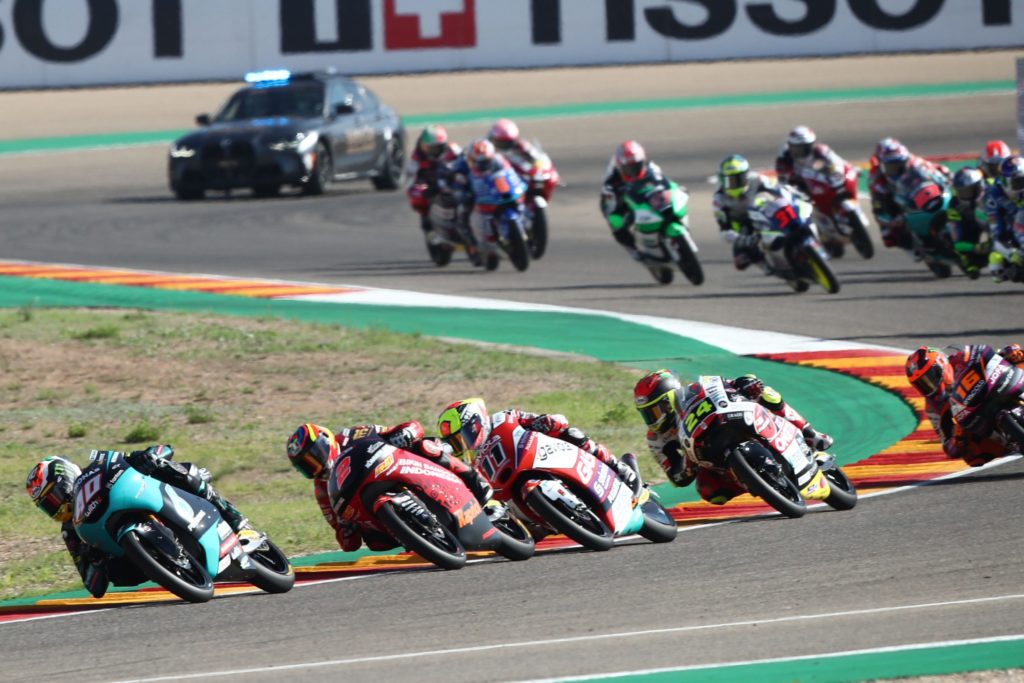How fast do MotoGP bikes go?
Have you ever wondered how fast do MotoGP bikes go?
MotoGP (Motorcycle Grand Prix) is recognised as the premium motorcycle racing series in the world. A study of the history of MotoGP racing shows that the speed of the bikes has depended largely on the tweaking of the regulations by the FIM. A look at the top speed of MotoGP bikes since the turn of the century will reveal that abundantly. With the advance of science and technology, the speed of bikes has increased gradually. The Fédération Internationale de Motocyclisme (FIM or the International Motorcycle Federation), cannot be blamed for the changes in regulations. It was just trying to regulate racing with safety requirements and technical developments.
MotoGP bikes are purpose-built racing machines meant only for racing built for racing circuits. These bikes are designed and tuned factory-built machines for specific pilots. They are not available for purchase to the general public. No roads and transport authorities around the world will allow these bikes to ply on public roads. The pilots recruited to race in MotoGP are experienced and prequalified.
The Fédération Internationale de Motocyclisme (FIM; international Motorcycle federation) was established in 1949. That was a time when motorcycle and engine technology was developing and motorcycles with various engine sizes were on the scene. Races were based on engine size and ranged from 50cc to 750cc through the second half of the 20th century. The increased speeds due to better engine efficiency and better structural designs forced the FIM to change regulations frequently. The changes in regulations were mostly necessitated for increased pilot and spectator safety as well as better organisation of the races.
MotoGP cannot be compared with Formula 1. The latter is a competition where hundreds of millions are invested in the development of vehicles. The engine developers and constructors have much to gain in pouring the millions into the cars’ developments. Their brand gains prominence and the returns from marketing their products justify the expenditure. Motorcycle engine developers get much lesser gains from their marketable products because the cost of motorcycles is much less. They are in this sport only to establish their brand and get whatever gains they get in the market share.
So… how fast do MotoGP bikes go?

What regulation changes were made from 2000 by the FIM?
Throughout the second half of the twentieth century, there were a lot of changes in regulations. This was done to regulate and reduce the categories by engine sizes and also for better organisation of the sport. Further regulations were needed for pilot safety. Though they opted out for a few years, two-stroke engines ruled the roost in MotoGP for the most part.
In the 1970s the FIM had limited engines in the top racing categories to a maximum of 500cc with four cylinders. This was regardless of whether the engine was two-stroke or four-stroke. This created an upheaval in the ranks of engine manufacturers. Most manufacturers for two-stroke engines opted out because two=stroke they produced more torque as compared to the weight of the bike. Most of them later joined MotoGP with newer designs of two-stroke engines. It was only in 2002 that the FIM decided to phase out two-stroke engines.
In 2002, the FIM adopted the name MotoGP (Motorcycle Grand Prix) for the top division of racing. The championship was divided into four classes: MotoGP, Moto2, Moto3 and MotoE. A MotoGP season consists of nineteen races: 12 in Europe, three in Asia and 2 in the Americas. While the capacity of the engines used in MotoGP was changed to 990cc, MotoE raced with electric motorcycles. By 2003 most two-stroke engined motorcycles had dropped out of MotoGP. In 2007, the FIM reduced the engine capacity of MotoGP engines to 800cc.
Why did the MotoGP bike speeds improve since 2002?
In 1949, the World Championship bikes sped in the range of 140 kilometres per hour. In 2001, the maximum speed recorded in MotoGP was around 316.5 kilometres per hour. Within the past two decades, the MotoGP bike speeds have increased by almost 46 kilometres per hour. That is close to a 159 per cent appreciation of speed on the 1949 speed of world championship bikes. But the speed appreciation in the last two decades alone is 26.22 per cent of the appreciation of speed in MotoGP bikes in the past seventy-two years. Why is that so?
That is because the engine manufacturers have hit on an unbeatable engine formula in V4 four-stroke engines. They have decided that an engine with 90 degrees V gives the maximum output power to the bike. The advantage of a 90 degree V engine is that the crankshaft is short. The engine has an rpm of 1800 at maximum throttle. The crankshaft and the other engine parts have to rotate or oscillate at the same rpm or frequency. A shorter crankshaft and other engine parts will have more resilience as well as staying power. The rest depends on the engineers who balance the bike and the pilots that ride them.

What are the top ten fastest speed records in MotoGP?
MotoGP bikes normally race around an average speed of 165 to 185 kilometres per hour. The average speed depends on the amount of grip a pilot gets on the circuit, the severity of the corners and the weather conditions. In favourable conditions, a pilot will race at average speeds greater than 185 kilometres per hour. But pilots reach the highest speeds of a lap on the longer straights. Some circuits have long straights of up to a kilometre or more. Pilots often take advantage of these straights in recording the fastest speeds and lap times.
MotoGP fans were impressed when Andrea Dovizioso broke the world MotoGP speed at the Italian Grand Prix in 2019. He broke the record in the third free practice session on the 1,41 kilometre straight, one of the longest straights in the world. After a subdued MotoGP season in 2020 due to the Covid19 pandemic, the record was either broken or equalled nine times during the 2021 MotoGP season. Johann Zarco currently holds the record for the fastest speed achieved during a MotoGP weekend.
Johann Zarco attained a speed of 362.4 kilometres per hour at the Losail circuit in Qatar simply because he achieved it before Brad Binder. The Losail circuit in Qatar with a 1,068 meter long straight, along with the Mugello circuit in Italy have two of the longest straights among Moto GP circuits. Pilots make full use of these straights to reach top speeds. The Barwa Grand Prix at Qatar alone saw the top speed record equalled or surpassed six times.
Below are the top ten fastest speed record holders:
| Rank | Pilot | Speed Km/hr | Session | Grand Prix | Year |
| 1 | Jorge Martín | 363.6 | Race | Italian GP | 2022 |
| 2 | Johann Zarco | 362.4 | Free Practice 4 | Qatar GP | 2021 |
| =2 | Brad Binder | 362.4 | Free Practice 3 | Italian GP | 2021 |
| 4 | Johann Zarco | 360.0 | Qualifying 2 | Italian GP | 2021 |
| =4 | Enea Bastianini | 360 | Qualifying 2 | Italian GP | 2022 |
| 6 | Jorge Martín | 358.8 | Qualifying 1 | Qatar GP | 2021 |
| =6 | Enea Bastianini | 358.8 | Qualifying 1 | Italian GP | 2021 |
| =6 | Jack Miller | 358.8 | Qualifying 2 | Italian GP | 2021 |
| =6 | Darryn Binder | 358.8 | Race | Italian GP | 2022 |
| =6 | Johann Zarco | 358.8 | Warm Up | Italian GP | 2021 |
READ MORE: 10 Reasons Why MotoGP is better than F1
